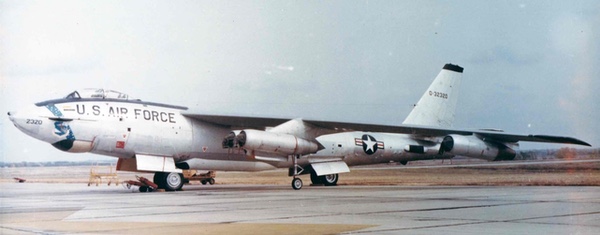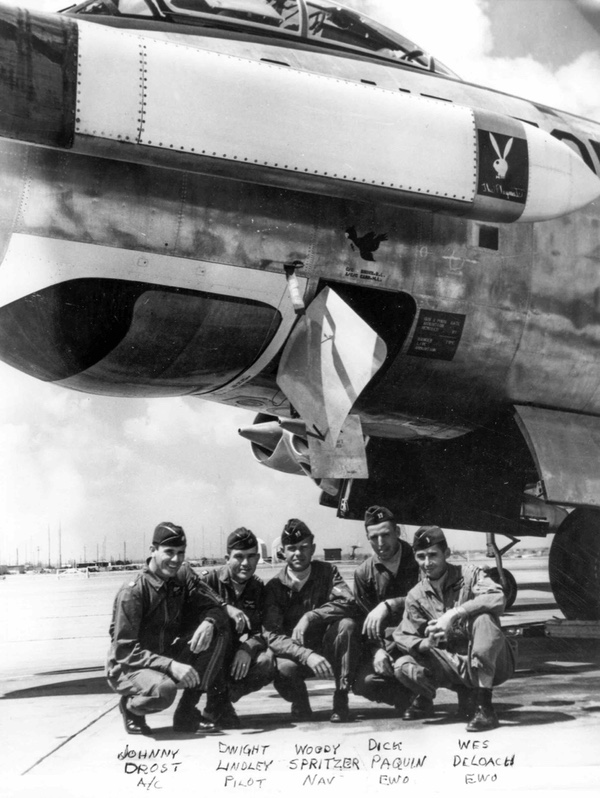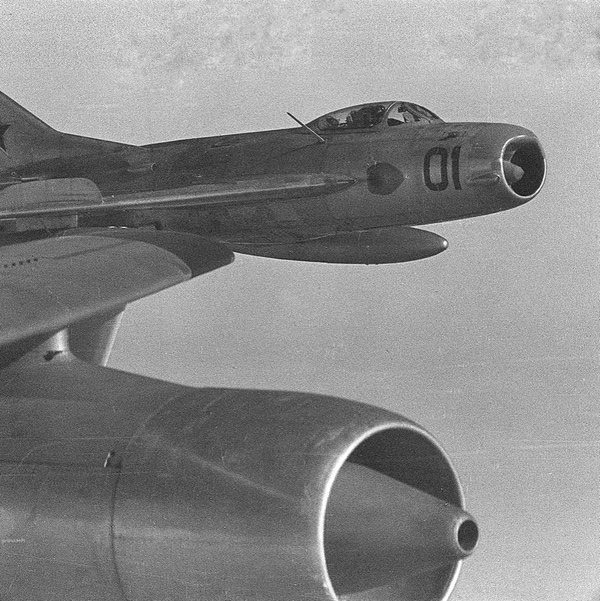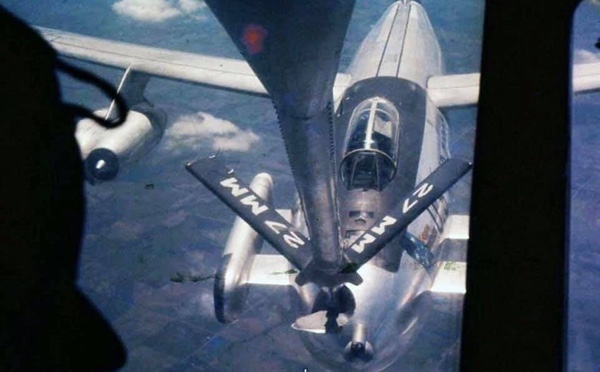Front line on the TELINT Cold WarThe Tell Two missions collecting rocket and satellite telemetry during the 1960sby Dwayne Day
|
| The EB-47E(TT) Stratojets played a role in intercepting telemetry from Soviet rocket launches, particularly the crucial first stage phase of flight which provided the most important data on the rocket’s performance. |
One of Bernard’s sources for information on the EB-47E(TT) missions was a 1990 article by Dr. Robert Hopkins III.[2] Hopkins has written numerous books and articles on aircraft, particularly the C-135. He used to pilot the specialized RC-135 Cobra Ball that monitored Soviet and other nations’ reentry vehicle tests. Since his 1990 article, Hopkins has updated the Tell Two story, most recently in a 2018 book on the B-47 bomber, and is currently researching the aircraft and their missions. To date, Hopkins’s 1990 article and 2018 book remain the best published sources on the EB-47E(TT) Tell Two aircraft, which were the predecessors to the Cobra Ball.[3]
According to Hopkins, in 1957, two specially modified ERB-47H aircraft were delivered to the 55th Strategic Reconnaissance Wing at Forbes Air Force Base in Kansas. The B-47 was a front-line medium bomber for Strategic Air Command, and more than 2,000 of them entered Air Force service after becoming operational in 1951. These two aircraft were equipped to detect and record both Soviet missile telemetry and general electronic intelligence information. However, it quickly became apparent to Strategic Air Command that the aircraft were inadequate for collecting telemetry intelligence. The aircraft modifications were funded as part of the IRON WORK program; “IRON” indicated that the money was probably provided by the CIA.[4]
After the limitations of the two ERB-47H aircraft became known, SAC then ordered three newly modified aircraft to replace them. These were B-47Es produced by Boeing’s Wichita factory and modified starting in March 1958. (The aircraft were serial numbers 53-2315, 53-2316, and 53-2320.) In September 1961, the three EB-47E aircraft were redesignated as EB-47E(TT) for “Tell Two.” These aircraft were assigned to the 55th Strategic Reconnaissance Wing at Forbes until 1967, when the remaining aircraft moved with the wing to Offutt Air Force Base, Nebraska. The aircraft routinely operated from Incirlik Air Base near Adana, Turkey, and occasionally deployed to other locations in the Pacific.
The aircraft were equipped with a special compartment Electronic Warfare Officer “pod” mounted in the bomb bay. A similar “Phase V Capsule” had been carried in other specialty versions of the B-47. The pod carried two Electronic Warfare Officers—nicknamed “Ravens”—along with their electronic gear. The two officers sat in downward-firing ejection seats during flight but moved to seats near the pilot and copilot during takeoff and landing, when an ejection would have killed them.
According to Hopkins, “The reconnaissance system was a series of fixed-frequency receivers connected to recording devices. The system had a limited ability to evaluate other than preprogrammed frequencies and in these cases was controlled directly by one or both of the Ravens. In addition to monitoring the reconnaissance gear, the Ravens spent a great deal of time changing reels of recording tape, a routine if not boring job.”[5]
The aircraft initially had large, rectangular antennas mounted to either side of their noses, giving them a distinct appearance, but these were later replaced with smaller, less-conspicuous antennas.
 One of three Tell Two aircraft. Two electronic warfare officers sat in a pod in the aircraft's converted bomb bay and monitored Soviet missile, rocket, and satellite telemetry. They had downward-facing ejection seats that could not be used during takeoffs and landings. (credit: Robert S. Hopkins III) |
Front line of the Cold War
Turkey was well-suited for intelligence operations against the Soviet Union during the Cold War, and two of the Tell Two aircraft were regularly deployed there. Aircraft flying out of Incirlik could monitor launches from both the Kapustin Yar launch base and the massive Baikonur test range, then referred to as Tyuratam by the US intelligence community. The planes would orbit over the Black Sea to monitor launches from Kapustin Yar, and over Iran to monitor Baikonur. At Incirlik, at least one aircraft and two Tell Two crews were kept on readiness alert, prepared to scramble in under 15 minutes upon receiving a go order, running to their planes and firing up their engines and heading to their patrol stations at maximum speed. This quick response time was vital to getting the planes airborne and in position to collect the signals coming from Soviet missiles, particularly during the early periods of flight. On several occasions both aircraft were airborne at the same time.[6]
| “Whereas the vaunted U-2 photos showed how few missiles the Soviets had and the extensive time needed to prepare and launch them, TELINT revealed just how ineffective those few missiles were,” Hopkins wrote. |
Throughout the Cold War, the United States lost numerous intelligence assets due to political instability. Key listening facilities in Pakistan had to be closed due to deteriorating relations or, in the cases of Ethiopia and Iran, revolutionary movements. Aircraft operations were not immune to changes in the political winds. The specialty Tell Two EB-47E(TT)s monitored missile launches from high over Iran, something known only to that country’s leadership. In late 1959, one of the aircraft was photographed over Iran and the photos published in an Iranian newspaper, leading to public uproar and a halt to the flights. When things settled down by early 1960, the flights over Iran resumed.
The Soviet launch of Sputnik in October 1957 had led to concern about the so-called “Missile Gap,” the belief that the Soviet Union was far outpacing the United States in the production and capability of intercontinental ballistic missiles (ICBMs). Both Richard Bernard in his TELINT history and Hopkins in his 2018 book note that intelligence assessments of Soviet missile capabilities in the late 1950s and early 1960s that indicated that Soviet ICBMs were less capable and less numerous than feared depended not only on photographs taken by high-flying U-2s, but the signals collected by numerous aircraft, including the Tell Twos. “Whereas the vaunted U-2 photos showed how few missiles the Soviets had and the extensive time needed to prepare and launch them, TELINT revealed just how ineffective those few missiles were,” Hopkins wrote in 2018.[7]
The first telemetry collection from a Soviet ICBM took place in December 1958, with the first joint mission involving a CIA U-2 and a Strategic Air Command EB-47E(TT) occurring in June 1959. This telemetry interception mission involved a Soviet R-7 ICBM launched from Baikonur. Later Tell Two missions collected telemetry from Soviet space flights. In February 1965, a Tell Two aircraft detected signals from Cosmos 57, a prototype of the manned Voskhod spacecraft. The collected information indicated that the Soviets were testing an airlock on the spacecraft, hinting that they were planning a spacewalk. Alexei Leonov did his spacewalk a little more than a month later, and a Tell Two aircraft was ready.[8]
The aircraft had sufficient fuel to stay airborne for several hours after a rocket launch, enabling them to collect telemetry from the launch itself, as well as when the satellite passed overhead after its first orbit and downloaded its status information to the ground. In October 1963, both aircraft were launched and monitored the Cosmos 20 reconnaissance satellite, with one aircraft landing after nearly seven hours in the air and the other landing ten hours after takeoff.[9] The aircraft were in heavy demand during the latter half of 1965, stressing both aircraft and crews.
By December 1965, American relations with Turkey had soured and operational missions out of that country were halted, also scuttling plans to permanently base two of the aircraft and six crews at Incirlik. In his 2018 book, Hopkins indicates that records are incomplete on where the planes operated in 1966, and they may have resumed flights from Incirlik after a pause. The planes were then deployed to Wheelus Air Base in Libya starting in January 1967, then moved to Algiers, and eventually Torrejon Air Base, Spain.
The movement of the aircraft further away from the Soviet launch sites also resulted in a change in their mission, and according to Hopkins, while based at Wheelus they exclusively monitored the reentry of Soviet manned space flights. While at Torrejon, they required in-flight refueling to reach their operating areas, and it was no longer possible to launch them immediately upon indications that a rocket launch was imminent, thus limiting their effectiveness. The Tell Two missions ended in June 1967.
Throughout the 1960s the aircraft occasionally operated in the Pacific from Hickam Air Force Base in Hawaii. The Tell Two copilot used a large spectrographic camera to photograph the reentry of ballistic objects. That highlighted one of the aircraft’s limitations: the lack of optical tracking devices to complement the signals collection equipment.
According to Hopkins, pilots and navigators were assigned to Tell Two flights before being assigned to more risky RB-47 missions that flew on the periphery of the Soviet Union, occasionally being intercepted by Soviet MiGs. Ravens, however, were assigned to RB-47s first before being assigned to Tell Two missions. Tell Two assignments were not popular among their crews, primarily because Incirlik, Turkey, was a less desirable posting than England or Japan. Turkey was boring.
 Aircrew for a Tell Two aircraft consisted of pilot, co-pilot, navigator, and two “Ravens” who monitored electronic transmissions from a special pod inside the aircraft. (credit: Robert S. Hopkins III) |
The difficult B-47
The B-47 was an effective medium bomber, but it also earned a reputation as a difficult aircraft to fly. In particular, it could not handle high crosswinds on takeoff or landing. On April 3, 1965, aircraft 53-2320 crashed at Incirlik following an operational mission, killing the navigator in the crash and mortally injuring one of the Ravens, who died 30 hours later. The pilot had circled the airbase waiting for the winds to die down and only attempted landing after nearly running out of fuel. Because of the classified equipment onboard, there were no authorized divert bases.
| The Tell Two pilot claimed they had an RTF “return to fighter” button in the cockpit—the big antennas on their planes allowed them to command Soviet missiles to turn around and blow up the launching planes. That quickly shut up the F-100 pilots. |
Tell Two pilots later objected to being sent to Shemya Air Force Base, an Alaskan island in the Aleutians chain, which had notorious crosswinds. A second EB-47E(TT) was damaged during a crosswinds landing at Shemya. That aircraft was repaired and returned to service.
Earlier in the decade, the Air Force initiated an effort to replace its thirty-plus RB-47Hs with ten modified RC-135Bs to conduct missions on the periphery of the Soviet Union collecting electronic intelligence. The Air Force began planning to replace the Tell Two aircraft with RB-57B aircraft, then RB-57Fs. The RB-57F had a much higher operating altitude, increasing the ability to collect signals from missile and rocket launches. However, due to a complicated series of events, these plans fell apart.
The two remaining aircraft were retired from service in 1967 after the Strategic Reconnaissance Wing had been transferred from Kansas to Nebraska. The planes were replaced in their mission by more capable aircraft, the RC-135S Cobra Ball and the RC-135X Cobra Eye. Those aircraft not only had signals interception equipment, but also optical sensors that looked out of windows in the side of the fuselage, enabling them to observe Soviet reentry vehicles. After the retirement of the Tell Two aircraft, Strategic Air Command was without a boost-phase telemetry intelligence collection capability until the late 1990s, when it was added to the RC-135S Cobra Ball.[10]
 Pilot Johnny Drost took this photo of a Soviet MiG getting very close to a B-47 during the Cold War. (credit: Robert S. Hopkins III) |
Lifting the veil
The Tell Two missions were secretive, and the aircraft had an unusual appearance to anyone familiar with the standard B-47. They attracted attention from other Air Force pilots. One EB-47E(TT) pilot recounted how a group of F-100 pilots at Incirlik started bragging that their fighters were well-armed and they would protect the EB-47E(TT) aircraft if they ever got into trouble with Soviet MiGs. This prompted a Tell Two pilot to respond that they didn’t really require any assistance, since they had an RTF “return to fighter” button in the cockpit—the big antennas on their planes allowed them to command Soviet missiles to turn around and blow up the launching planes. That quickly shut up the F-100 pilots. “Most weren’t sure whether or not to believe us… and we left it that way,” remembered the Tell Two pilot.[11]
Robert Hopkins has obtained more information on the Tell Two missions and is writing an entire chapter on the aircraft for volume 2 of his 2016 book Spyflights and Overflights. One of his goals is to correlate the numerous aircraft missions with specific Soviet launches. He has gathered a significant amount of information on their operations, as well as related aircraft missions during the 1960s and later. His goal is to finally tell the story of these mysterious planes that operated during the middle of the Cold War.[12]
Endnotes
- Richard L. Bernard, The Foreign Missile and Space TELEMETRY Collection Story – The First 50 Years Part 1, “Chapter 1, In the Beginning (1950s),” p. 21.Part 1, “Chapter 2, The SPACOL Plan and DEFSMAC (Early 1960s),” p. 37.
- Robert Hopkins III, “The Tell Two Stratojets,” Air Enthusiast, 41, August 1990, pp. 18-21.
- Communications with Robert Hopkins, February 2022.
- Robert Hopkins III, Boeing B-47 Stratojet: Strategic Air Command’s Transitional Bomber, Crecy, 2018, p. 168.
- Robert Hopkins III, “The Tell Two Stratojets,” p. 19.
- Robert Hopkins III, Boeing B-47 Stratojet, p. 168.
- Ibid., p. 168.
- Ibid., p. 169.
- Ibid., p. 171.
- Ibid., p. 172.
- Jan Tegler, B-47 Stratojet: Boeing’s Brilliant Bomber, McGraw-Hill, 2000, p. 151.
- Communications with Robert Hopkins, February 2022.
Note: we are using a new commenting system, which may require you to create a new account.
